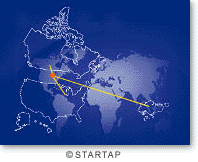


A longtime leader in computer networking, the National Science Foundation supported the original NSFNET, a scientific research network that converged with commercial interests to evolve into today's bustling Internet. With increasingly data-intensive research projects, scientists face daunting congestion and delay in transmitting their oversized data packets via the Internet, and require computer networks which are much higher-performance, with advanced visualization systems and massive data resources. For projects involving international collaborators – such as global warming monitoring or tele-immersion (collaborative virtual reality) – the data-transit problems multiply. When, for example, data traffic from Brazil needs to travel to Germany or Japan, there is no single telecommunications service to connect them directly. The result is that researchers who want to collaborate internationally spend valuable time and money negotiating with competing telecommunications carriers to establish a direct link.
These data transit problems are compounded by a commercial sector which tends to duplicate networking development efforts rather than collaborate to create new technology standards. To ensure that American research thrives beyond the fray, the National Science Foundation launched the vBNS -- very High Performance Backbone Network Service – a network that supports high-performance, high-bandwidth research and educational activities, with international connections. Since 1995, the vBNS (managed through a cooperative agreement between NSF and MCI) has provided an environment for experimenting and developing advanced Internet technologies. The high-speed network has a transmission capacity of 622 megabits per second (the average home modem is 28.8), expected to reach 2.4 gigabits by year 2000.

The vBNS is a vital tool for U.S. research and education (R&E;) institutions, for federal research laboratories and for NSF-approved R&E; organizations in other countries. The international vBNS connections program is based physically at the University of Illinois, Chicago, and dubbed STAR TAP – Science, Technology and Research Transit Access Point. This NSF-funded intercontinental Internet hub enables high-speed, high-bandwidth, consistently reliable traffic between dozens of American research universities or supercomputer centers and their global colleagues. As Tom DeFanti, STAR TAP's principal investigator and associate director at the National Center for Supercomputing Applications, says "The scientific community is worldwide, so it makes sense to collaborate, and (computer) networks are synonymous with collaboration." The vBNS enables scientists to access data, machines and people independent of where they reside, enhancing the quality, pace and scope of research activities for all involved.
The first international vBNS link at STAR TAP was to Canada's high-performance network, CANARIE, joined recently by the first trans-Pacific high-speed connection to SINGAREN -- Singapore Internet Next Generation Advanced Research and Education Network. Funded by the Singapore Government, SINGAREN'S vBNS connection is fostering fruitful virtual research relationships between experts in fields including medicine, education, manufacturing, design and tele-immersion. For example, the relation between Singapore's CieMed (Centre for Information-Enhanced Medicine) and Johns Hopkins University, Baltimore, generates leading-edge medical imaging for training and research purposes. Among other projects, their biomedical software applications, such as 3-D visualization modeling for virtual heart surgery, require a very high performance network to transfer the large amounts of data involved. Hence the value of the vBNS link.
By supporting vBNS and STAR TAP, the NSF continues its tradition of strengthening U.S. research institutions by enabling them to collaborate easily with international colleagues. These collaborations propel the global information infrastructure, creating the foundation for computer networks of the 21st century that are far more powerful and versatile than the Internet we know today. These scientific efforts will also stimulate industry, government and academia to introduce next-generation multimedia technologies and services in our businesses, schools and homes.
For more information please visit:
Singaren at http://www.singaren.net.sgThis research is partially supported by International Programs.
STAR TAP at http://www.startap.net